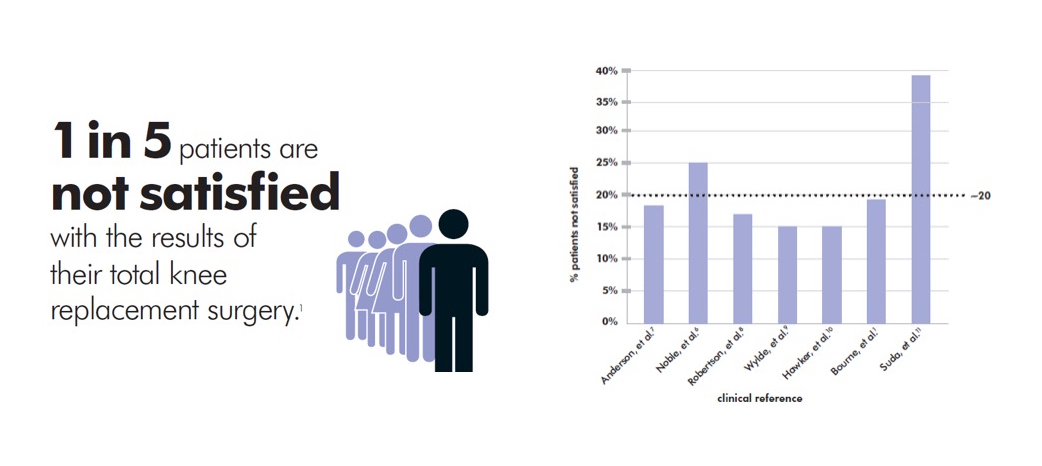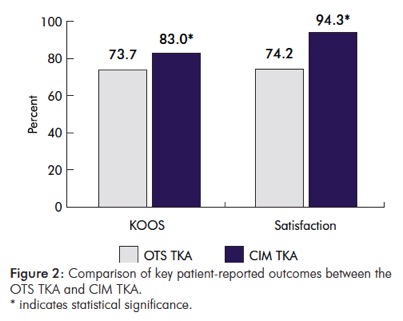The outcomes and results of knee replacement surgery.
Knee replacement surgery is an excellent treatment for people with severe end-stage arthritis. Most people do very well, and a successful knee replacement can give a patient their life back, and allow them to lead a pain-free existence, enjoying regular (non-impact) exercise and all of the normal activities of daily living. However, like pretty much all kinds of surgery, success can never be absolutely guaranteed. There are potential risks associated with any kind of surgery, and there are complications that can sometimes arise that can seriously adversely affect a patient’s outcome.
CLICK HERE to read more about the potential risks and possible complications of knee replacement surgery.
Even it everything seemingly goes well with the surgery itself, and even if there are no specific actual complications, some patients can still potentially end up not happy with their knee and with their outcome.
It is therefore essential that any patient contemplating potential knee replacement surgery should be fully aware of the likelihood of ‘success’ and the potential risks of not actually ending up happy with their new knee.
There are different ways of looking at outcomes and of quantifying ‘success’, and these need to be considered carefully.
Overall patient satisfaction
Results can vary quite widely between different research projects and audits, but published data suggests that about 80 to 85% of patients end up happy with their knee after standard (‘off-the-shelf’) knee replacement surgery
This means that with a standard knee replacement, up to 15 to 20% of patients might end up unhappy with their outcome. This doesn’t necessarily mean that there has been some kind of actual complication with the surgery itself (such as an infection or a blood clot) – it simply means that the patient’s new knee just hasn’t met that patient’s expectations of what they had anticipated or expected. It might be that the knee is stiff. There might still be some aching or even pain in or around the joint. The patient’s function might be restricted and they might not be able to do all of the things that they’d like to.
It is therefore important to appreciate before going ahead with knee replacement surgery that unfortunately, with surgery there are never any absolute guarantees. There are a lot of differences (both physically and also psychologically) between different patients, and what might work well for one person might not for another.
Probably the biggest evolutionary step in the development of knee replacement prostheses in the last 20+ years has been the development of custom-made knee replacement prostheses. Custom-made knee replacements are designed to match the exact size, shape and contours of each individual patient’s specific knee. They therefore replicate the kinematics (the movement) of that patient’s knee better, and they end up feeling more like the patient’s own normal knee.
Research has shown that patient satisfaction rates after knee replacement surgery with a custom-made prosthesis can be as high as 95%! This should not be considered as a 10 to 15% improvement in outcomes: instead, if you flip this round the other way, we are looking at a 66 to 75% reduction in the number of unhappy patients.
Can you run after a knee replacement?
Knee replacement prostheses were originally designed for older lower-demand patients. However, as the technology and the materials we use have got better, artificial joints have become more hard-wearing, with them tending to last longer.
Importantly, however, the more you ‘pound’ a knee prosthesis after knee replacement surgery, then the faster the rate of wear and tear will be, the quicker the artificial joint will wear out, and the higher the probability of the prosthesis ending up failing within your lifetime, with you ending up needing a revision… and revision knee replacement surgery is twice as complex and difficult, with double the potential risks and with poorer outcomes (compared to a primary – i.e. the first one).
So, even if a patient ends up feeling physically capable of impact exercise once they’ve recovered from their knee replacement surgery, the sensible approach is to avoid running or other impact-type sport.
Some people do manage to go back to tennis, for example – but if you do, then you really should stick just to gentle non-competitive doubles only, to reduce the impact on your new knee. Likewise, some people manage to go back to skiing – but again, this is not ideal as skiing is really tough on the knees. Instead, you would be far better off sticking purely (or at least predominantly) to just light non-impact cardio type exercise such as walking, cycling / the exercise bike, the cross-trainer and swimming. However, this is all very much a lifestyle choice and largely down to the personality of the individual patient.
CLICK HERE to see what can be achieved with a custom-made knee replacement.
Can you kneel on a knee replacement?
This is something that’s quite unpredictable.
About 50% of patients say that they can kneel comfortably after knee replacement surgery, but 50% find it too uncomfortable, and they might have to use a soft cushion to kneel or or, possibly, not even feel comfortable enough to kneel at all.
How long does a knee replacement last?
More than 95% of knee replacements last at least 10 years, with about 80% still working after 20 years.
So, only 5% have needed a revision/re-do by 10 years, and only 20% by 20 years.
Therefore, if you look after your knee replacement carefully, then there’s a very good chance that it will outlast you! This is, however, significantly affected by the patient’s age…
The younger you are, the more active you are likely to be, and hence the faster the rate of wear and tear on the knee prosthesis will be, and the more likely it is that the joint will wear out and fail within your liftetime. Also, the younger you are, the longer you are (hopefully!) going to live, and so this is a bit of a ‘double-whammy’!…
If you are in your 70’s, then there’s only a 10% chance that your knee prosthesis will fail within your lifetime and end up needing to be revised, but there’s a 90% chance that the prothesis will outlast you, and therefore ‘last a lifetime’.
If you’re in your 50’s, however, when you have your knee replacement, then there’s a 50% chance of you ending up needing revision knee replacement surgery at some stage in the future, within your lifetime.
This is why age is an important factor to consider when deciding when the right time is to actually go ahead with knee replacement surgery.
CLICK HERE for further information about prosthetic survivorship rates.



